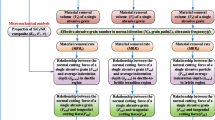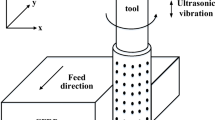Abstract
Ultrasonic-assisted machining of silicon carbide (SiC) ceramic matrix composites (CMCs) has the ability to decrease grinding force and improve processing quality. The machining process often produces large cutting forces which cause defects, such as delamination and burrs, due to the brittleness and high hardness of the material. Therefore, it is significant to precisely predict the grinding force. In published literature, the modelling of cutting force has been investigated based on brittle removal assumption. However, a ductile flow phenomenon exists simultaneously during the micro-grinding of CMCs. Hence, in this paper, we present an analytical model of grinding force with the consideration of ductile–brittle transition. Additionally, the critical cutting depth for removal mode transition can be applied to distinguish the ductile and brittle fracture removal processes. The establishment of the analytical model was on the basis of the research of single abrasive grain, including motion trajectory, micromechanical analysis, cutting time, and removal volume in ductile and brittle fracture processes during one cutting cycle. Thereafter, the final model was proposed with respect to the quantity of active abrasive grains in the cutting area. The trend of the experiment results was in good agreement with the predicted values of the analytical model.















Similar content being viewed by others
Data availability
The datasets analyzed during the current study are available from the corresponding author on reasonable request.
References
Chung D (2001) Materials for thermal conduction. Appl Therm Eng 21:1593–1605
Zhang M, Pang Z, Jia Y, Shan C (2022) Understanding the machining characteristic of plain weave ceramic matrix composite in ultrasonic-assisted grinding. Ceram Int 48:5557–5573
Shan C, Zhang M, Yang Y, Zhang S, Luo M (2020) A dynamic cutting force model for transverse orthogonal cutting of unidirectional carbon/carbon composites considering fiber distribution. Compos Struct 251:112668
Bansal NP (2005) Handbook of ceramic composites. Springer, Boston
Liu Y, Geng D, Shao Z, Zhou Z, Jiang X, Zhang D (2021) A study on strengthening and machining integrated ultrasonic peening drilling of Ti-6Al-4V. Mater Design 212:110238
Cao Y, Yin J, Ding W, Xu J (2021) Alumina abrasive wheel wear in ultrasonic vibration-assisted creep-feed grinding of Inconel718 nickel-based superalloy. J Mater Process Technol 297:117241
Cao Y, Zhu Y, Ding W, Qiu Y, Wang L, Xu J (2022) Vibration coupling effects and machining behavior of ultrasonic vibration plate device for creep-feed grinding of Inconel 718 nickel-based superalloy. Chin J Aeronaut 35:332–345
Cao Y, Ding W, Zhao B, Wen X, Li S, Wang J (2022) Effect of intermittent cutting behavior on the ultrasonic vibration-assisted grinding performance of Inconel718 nickel-based superalloy. Precis Eng 78:248–260
Geng D, Liu Y, Shao Z, Zhang M, Jiang X, Zhang D (2020) Delamination formation and suppression during rotary ultrasonic elliptical machining of CFRP. Compos Part B Eng 183:107698
Miao Q, Ding W, Xu J, Cao L, Wang H, Yin Z, Dai C, Kuang W (2021) Creep feed grinding induced gradient microstructures in the superficial layer of turbine blade root of single crystal nickel-based superalloy. Int J Extrem Manuf 3(4):045102
Hocheng H, Tai NH, Liu CS (2000) Assessment of ultrasonic drilling of C/SiC composite material. Compos Appl Sci Manuf 31(2):133–142
Li ZC, Jiao Y, Deines TW, Pei ZJ, Treadwell C (2005) Rotary ultrasonic machining of ceramic matrix composites: feasibility study and designed experiments. Int J Mach Tools Manuf 45:1402–1411
Shan C, Zhang X, Dang J, Yang Y (2017) Rotary ultrasonic drilling of needle-punched carbon/carbon composites: comparisons with conventional twist drilling and high-speed drilling. Int J Adv Manuf Technol 98:189–200
Bertsche E, Ehmann K, Malukhin K (2012) An analytical model of rotary ultrasonic milling. Int J Adv Manuf Technol 65:1705–1720
Islam S, Yuan SM, Li Z (2020) A cutting force prediction model, experimental studies, and optimization of cutting parameters for rotary ultrasonic face milling of C/SiC composites. Appl Compos Mater 27:407–431
Pei ZJ, Ferreira PM, Haselkorn M (1995) Plastic flow in rotary ultrasonic machining of ceramics. J Mater Process Technol 48:771–777
Pei ZJ, Ferreira PM (1998) Modeling of ductile-mode material removal in rotary ultrasonic machining. Int J Mach Tools Manuf 38:1399–1418
Chen J, An QL, Chen M (2020) Transformation of fracture mechanism and damage behavior of ceramic-matrix composites during nano-scratching. Compos Part A Appl Sci Manuf 130:105756
Chen MJ, Zhao QL, Dong S, Li D (2005) The critical conditions of brittle-ductile transition and the factors influencing the surface quality of brittle materials in ultra-precision grinding. J Mater Process Technol 168:75–82
Huang C, Zhou M, Zhang H (2022) Investigations on the micro-interactions of grit-workpiece and forces prediction in ultrasonic vibration side grinding of optical glass. J Mater Process Technol 300:117415
Barbero EJ (2017) Introduction to composite materials design. CRC Press, Boca Raton
Wang H, Pei ZJ, Cong WL (2020) A mechanistic cutting force model based on ductile and brittle fracture material removal modes for edge surface grinding of CFRP composites using rotary ultrasonic machining. Int J Mech Sci 176:105551
Wang H, Pei ZJ, Cong WL (2020) A feeding-directional cutting force model for end surface grinding of CFRP composites using rotary ultrasonic machining with elliptical ultrasonic vibration. Int J Mach Tools Manuf 152:103540
Lee SK, Byun JH, Hong SH (2003) Effect of fiber geometry on the elastic constants of the plain woven fabric reinforced aluminum matrix composites. Mater Sci Eng A Struct 347:346–358
Lawn BR, Marshall DB (1979) Hardness, toughness, and brittleness: an indentation analysis. J Am Ceram Soc 62:347–350
Malkin S, Guo C (2008) Grinding technology: theory and applications of machining with abrasives. Industrial press, New York
Lawn B, Wilshaw R (1975) Indentation fracture: principles and applications. J Mater Sci 10:1049–1081
Li C, Zhang FH, Meng BB, Liu LF, Rao XS (2017) Material removal mechanism and grinding force modelling of ultrasonic vibration assisted grinding for SiC ceramics. Ceram Int 43:2981–2993
Xiao X, Zheng K, Liao W, Meng H (2016) Study on cutting force model in ultrasonic vibration assisted side grinding of zirconia ceramics. Int J Mach Tools Manuf 104:58–67
Lawn BR, Evans AG, Marshall DB (1980) Elastic/plastic indentation damage in ceramics: the median/radial crack system. J Am Ceram Soc 63:574–581
Marshall DB, Lawn BR, Evans AG (1982) Elastic/plastic indentation damage in ceramics: the lateral crack system. J Am Ceram Soc 65:561–566
Du J, Ming W, Ma J, He W, Cao Y, Li X et al (2018) New observations of the fiber orientations effect on machinability in grinding of C/SiC ceramic matrix composite. Ceram Int 44:13916–13928
Li K, Liao TW (1996) Surface/subsurface damage and the fracture strength of ground ceramics. J Mater Process Technol 57:207–220
Acknowledgements
The authors deeply acknowledge the Key Laboratory of High Performance Manufacturing for Aero Engine (Northwestern Polytechnical University) and Engineering Research Center of Advanced Manufacturing Technology for Aero Engine (Northwestern Polytechnical University) for providing us with the ability to conduct this research.
Funding
This work was co-supported by the National Natural Science Foundation of China (nos. 51875473 and 91960203) and the Science Center for Gas Turbine Project (P2021-A-IV-003–001).
Author information
Authors and Affiliations
Contributions
Menghua Zhang: methodology, validation, writing—original draft. Ziwen Xia: visualization, investigation. Chenwei Shan: conceptualization, methodology, supervision, funding acquisition, writing—review and editing. Ming Luo: supervision, writing—review and editing.
Corresponding author
Ethics declarations
Ethics approval
This paper does not include any research conducted by any author with humans or animals as participants.
Consent to participate
Not applicable.
Consent for publication
Not applicable.
Competing interests
The authors declare no competing interests.
Additional information
Publisher's note
Springer Nature remains neutral with regard to jurisdictional claims in published maps and institutional affiliations.
Rights and permissions
Springer Nature or its licensor (e.g. a society or other partner) holds exclusive rights to this article under a publishing agreement with the author(s) or other rightsholder(s); author self-archiving of the accepted manuscript version of this article is solely governed by the terms of such publishing agreement and applicable law.
About this article
Cite this article
Zhang, M., Xia, Z., Shan, C. et al. Analytical model of grinding force for ultrasonic-assisted grinding of Cf/SiC composites. Int J Adv Manuf Technol 126, 2037–2052 (2023). https://doi.org/10.1007/s00170-023-11257-9
Received:
Accepted:
Published:
Issue Date:
DOI: https://doi.org/10.1007/s00170-023-11257-9




